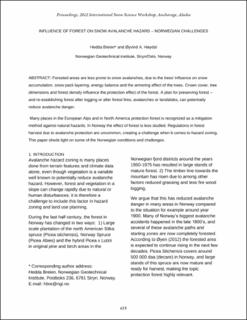| dc.contributor.author | Breien, Hedda | |
| dc.contributor.author | Høydal, Øyvind A. | |
| dc.date.accessioned | 2023-08-14T11:05:28Z | |
| dc.date.available | 2023-08-14T11:05:28Z | |
| dc.date.issued | 2012 | |
| dc.identifier.uri | https://hdl.handle.net/11250/3083802 | |
| dc.description.abstract | Forested areas are less prone to snow avalanches, due to the trees' influence on snow accumulation, snow pack layering, energy balance and the armoring effect of the trees. Crown cover, tree dimensions and forest density influence the protection effect of the forest. A plan for preserving forest – and re- establishing forest after logging or after forest fires, avalanches or landslides, can potentially reduce avalanche danger. Many places in the European Alps and in North America protection forest is recognized as a mitigation method against natural hazards. In Norway the effect of forest is less studied. Regulations in forest harvest due to avalanche protection are uncommon, creating a challenge when it comes to hazard zoning. This paper sheds light on some of the Norwegian conditions and challenges. | en_US |
| dc.language.iso | eng | en_US |
| dc.publisher | Montana State University Library | en_US |
| dc.relation.ispartofseries | The International Snow Science Workshop (ISSW) Proceedings; | |
| dc.subject | Avalanche-RnD | en_US |
| dc.subject | Snøskred-FoU | en_US |
| dc.title | Influence of forest on snow avalanche hazard – norwegian challenges | en_US |
| dc.type | Chapter | en_US |
| dc.source.pagenumber | 6 | en_US |
| dc.identifier.doi | https://arc.lib.montana.edu/snow-science/item/1616 | |
